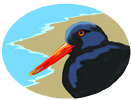
Pelagic Cormorants do not live up to their names. Rather than going far out in the open ocean they stay within a few miles of shore. They are year-round residents. At 28 inches in length they are the smallest cormorants. They are distinguished by being skinny with a thin bill. Their slender neck sticks straight out in flight and has been described as looking like a broomstick. At close range their dark feathers have a shiny metallic blue and green gloss. In spring they are easy to identify by the two white flank patches seen in flight. The breeding adultís bare throat patch is ruby red.
Pelagic Cormorants can be recognized by their of nest site on the offshore rocks. While Brandtís Cormorants nest on top of islets and flat rocks, Pelagic Cormorants nest on the highest, steepest, least accessible rocky cliffs facing the water. Their tiny ledge nests seem to defy gravity. They nest in loose colonies , which include nonbreeders returning at night to roost. A breeding pair builds the nest together, one gathering seaweed, grass and sticks while the other builds. They will return to the same nest each year and add to it so that some nests have reached 6 feet. The female lays 3-5 bluish-white eggs. The pair takes turns incubating for 26-37 days. The eggs hatch asynchronously with the first being the largest and the last not normally surviving in lean years.
Cormorants dive for fish. Their eyes are adapted to see both in air and under water. Their outer feathers are designed to absorb water, allowing them to dive deeper, while the inner feathers are waterproof for warmth. This is why cormorants stand around with their wings spread open: to allow them to dry. Pelagic cormorants dive through the surf and around boulders. They have been known to dive over 120 feet. They catch sculpins, herring, tomcod and flounders. Since cormorants swallow their fish whole, they will regurgitate pellets of the indigestible parts. These pellets are great tools for scientist to discern important food patterns.
Pelagic Cormorant on a nest Photo Ron LeValley, levalleyphoto.com
